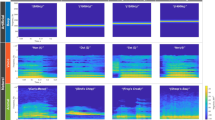Abstract
The purpose of this study was to identify the impact of different discriminative features of stimuli in a P300 brain-computer interface paradigm on overall performance and evoked potentials. It has been shown that stimuli sets with a greater number of discriminative features yield better target selection accuracy. Target selection accuracy was significantly higher for the stimuli that differ from each other by color, shape, and semantics. Highest performance was achieved with the stimuli set containing the largest number of discriminative features, namely a set of nine different-colored letters. This result is mainly due to higher mean P300 peak amplitude for stimuli sets that contain more discriminative features. The results of the study can be used for designing a better user experience in brain-computer interfacing (BCI). Motion of the stimuli presentation point and characteristics of this motion (linear or pseudorandom) did not have any impact on BCI performance. This result is promising for future BCI designs with rapid serial visual presentation using mobile robots or augmented reality as stimuli presentation environment.
Similar content being viewed by others
References
Powers, J.C., Bieliaieva, K., Wu, S., and Nam, C.S., The human factors and ergonomics of P300-based brain-computer interfaces, Brain Sci., 2015, vol. 5, no. 3, pp. 318–356.
Farwell, L.A. and Donchin, E., Talking off the top of your head: Toward a mental prosthesis utilizing eventrelated brain potentials, Electroencephalogr. Clin. Neurophysiol., 1988, vol. 70, no. 6, pp. 510–523.
Polich, J., Updating p300: An integrative theory of P3a and P3b, Clin. Neurophysiol., 2007, vol. 118, no. 10, pp. 2128–2148.
Jin, J., Allison, B.Z., Kaufmann, T., Kubler, A., Zhang, Y., Wang, X., and Cichocki, A., The changing face of P300 BCIs: A comparison of stimulus changes in a P300 BCI involving faces, emotion, and movement, PLoS One, 2012, vol. 7, no. 11, e49688.
Guger, C., Daban, S., Sellers, E., Holzner, C., Krausz, G., Carabalona, R., Gramatica, F., and Edlinger, G., How many people are able to control a P300-based braincomputer interface (BCI)?, Neurosci Lett., 2009, vol. 462, no. 1, pp. 94–98.
Kaplan, A.Ya., Neurophysiological foundations and practical realizations of the brain-machine interfaces the technology in neurological rehabilitation, Hum. Physiol., 2016, vol. 42 N, pp. 103–110.
Jin, J., Allison, B.Z., Wang, X., and Neuper, C., A combined brain-computer interface based on P300 potentials and motion-onset visual evoked potentials, J. Neurosci. Methods, 2012, vol. 205, no. 2, pp. 265–276.
Guo, F., Hong, B., Gao, X., and Gao, S., A braincomputer interface using motion-onset visual evoked potential, J. Neural Eng., 2008, vol. 5, no. 4, pp. 477–485.
Acqualagna, L., Treder, M.S., Schreuder, M., and Blankertz, B., A novel brain-computer interface based on the rapid serial visual presentation paradigm, Engineering in Medicine and Biology Society (EMBC), 2010 Annual International Conference of the IEEE, Buenos Aires, 2010, pp. 2686–2689.
Yeh, Y.Y., Lee, D.S., and Ko, Y.H., Color combination and exposure time on legibility and EEG response of icon presented on visual display terminal, Displays, 2013, vol. 34, no. 1, pp. 33–38.
Salvaris, M., Cinel, C., Citi, L., and Poli, R., Novel protocols for P300-based brain-computer interfaces, IEEE Trans. Neural Syst. Rehabil. Eng., 2012, vol. 20, no. 1, pp. 8–17.
Proverbio, A.M., Burco, F., del Zotto, M., and Zani, A., Blue piglets? Electrophysiological evidence for the primacy of shape over color in object recognition, Cognit. Brain Res., 2004, vol. 18, no. 3, pp. 288–300.
Ganin, I.P., Shishkin, S.L., and Kaplan, A.Y., A P300-based brain-computer interface with stimuli on moving objects: Four-session single-trial and triple-trial tests with a game-like task design, PLoS One, 2013, vol. 8, no. 10, e77755.
Tang, J., Zhou, Z., and Liu, Y., A 3D visual stimuli based P300 brain-computer interface: For a robotic arm control, Proceedings of the 2017 International Conference on Artificial Intelligence, Automation and Control Technologies, Wuhan, 2017, p. 18.
Seabold, S. and Perktold, J., Statsmodels: Econometric and statistical modeling with Python, Proceedings of the 9th Python in Science Conference, Austin, 2010, vol. 57, p. 61.
Author information
Authors and Affiliations
Corresponding author
Additional information
Original Russian Text © R.K. Grigoryan, E.U. Krysanova, D.A. Kirjanov, A.Ya. Kaplan, 2018, published in Vestnik Moskovskogo Universiteta, Seriya 16: Biologiya, 2018, Vol. 73, No. 2, pp. 111–117.
About this article
Cite this article
Grigoryan, R.K., Krysanova, E.U., Kirjanov, D.A. et al. Visual Stimuli for P300-Based Brain-Computer Interfaces: Color, Shape, and Mobility. Moscow Univ. Biol.Sci. Bull. 73, 92–96 (2018). https://doi.org/10.3103/S0096392518020037
Received:
Accepted:
Published:
Issue Date:
DOI: https://doi.org/10.3103/S0096392518020037




